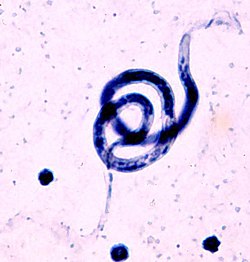Brugia malayi
| Brugia malayi | |
 | |
| Systematik | |
|---|---|
| Domän | Eukaryoter Eukaryota |
| Rike | Djur Animalia |
| Stam | Rundmaskar Nematoda |
| Klass | Secernentea |
| Ordning | Spirurida |
| Familj | Filariidae eller Onchocercidae |
| Släkte | Brugia |
| Art | Brugia malayi |
| Vetenskapligt namn | |
| § Brugia malayi | |
| Auktor | (Brug 1927) |
| Hitta fler artiklar om djur med | |
Brugia malayi är en rundmask, en av de tre arterna som orsakar lymfatisk filariasis hos människor. Lymfatisk filariasis är en sjukdom som karaktäriseras av uppsvällda ben.[1]
B. malayi överförs av myggor. Dess utbredningsområde är Sydasien och Sydostasien. Detta är en av de tropiska sjukdomar som Världshälsoorganisationen har föresatt sig att utplåna till år 2020. Detta har i sin tur stimulerat utveckling av vacciner, mediciner och metoder att hålla tillbaka myggorna som sprider dessa rundmaskar.
De viktigaste spridarna är myggor i släktena Mansonia, Anopheles och Aedes.[2] För att få sjukdomen krävs det att man får åtminstone flera hundra infekterande stick.[3]
B. malayi infekterar 13 miljoner människor och står därmed för 10% av det totala antalet fall av lymfatisk filariasis i världen.
Referenser
- Artikeln baseras på webbplatsen US Dept. of Health and Human Services / Center for Disease Control: Filariasis som tillhör den Amerikanska (USA) staten och inte är copyright-skyddad.
- ^ Johhn, David T., and William A. Petri. Markell and Voge's Medical Parasitology. 9th ed. St. Louis: Saunders Elsevier, 2006.
- ^ ”Gideon Infectious Diseases Online. Brugia Malayi.”. http://web.gideononline.com/web/epidemiology/index.php?disease=10930&country=&view=General.
- ^ Fischer, P.; Erickson, S. M.; Fischer, K.; Fuchs, J. F.; Rao, R. U.; Christensen, B. M. & Weil, G. J. (2007), ”Persistence of Brugia Malayi DNA in vector and non-vector mosquitoes: implication for xenomonitoring and transmission monitoring of lymphatic filariasis”, American Journal of Tropical Medicine Hygiene 76 (3): 502–507, http://www.ajtmh.org/cgi/content/abstract/76/3/502
Externa länkar
- Brugia_life_cycle_and_adults_in_lymphatics video by R. Rao
- Brugia malayi at UMich
- The Special Programme for Research and Training in Tropical Diseases (TDR). "Functional analysis of Brugia malayi genes". 2004
- University of Pittsburgh. "Researchers reveal genetic secrets of devastating human parasite". 20 September 2007.
- Hoerauf, Achim. "Targeting wolbachia, doxycycline reduces pathology of lymphatic filariasis". 18, September 2006.
- The World Health Organization’s Global Program to Eliminate Lymphatic Filariasis
- The Global Alliance to Eliminate Lymphatic Filariasis
- Gideon Infectious Diseases Online
- Parasite Image Library, Centers for Disease Control
Media som används på denna webbplats
Filariasis [B. malayi microfilaria]
Microfilaria of Brugia malayi. Thick blood smear, hematoxylin stain. Like Wuchereria bancrofti, this species has a sheath (slightly stained in hematoxylin). Differently from Wuchereria, the microfilariae in this species are more tightly coiled, and the nuclear column is more tightly packed, preventing the visualization of individual cells.Filariasis
Life cycle of Brugia malayi
The typical vector for Brugia malayi filariasis are mosquito species from the genera Mansonia and Aedes. During a blood meal, an infected mosquito introduces third-stage filarial larvae onto the skin of the human host, where they penetrate into the bite wound. They develop into adults that commonly reside in the lymphatics. The adult worms resemble those of Wuchereria bancrofti but are smaller. Female worms measure 43 to 55 mm in length by 130 to 170 μm in width, and males measure 13 to 23 mm in length by 70 to 80 μm in width. Adults produce microfilariae, measuring 177 to 230 μm in length and 5 to 7 μm in width, which are sheathed and have nocturnal periodicity. The microfilariae migrate into lymph and enter the blood stream reaching the peripheral blood. A mosquito ingests the microfilariae during a blood meal. After ingestion, the microfilariae lose their sheaths and work their way through the wall of the proventriculus and cardiac portion of the midgut to reach the thoracic muscles. There the microfilariae develop into first-stage larvae and subsequently into third-stage larvae. The third-stage larvae migrate through the hemocoel to the mosquito's prosbocis and can infect another human when the mosquito takes a blood meal.

